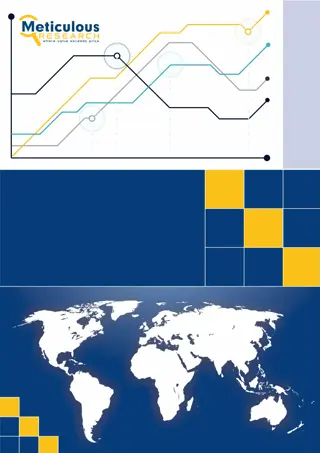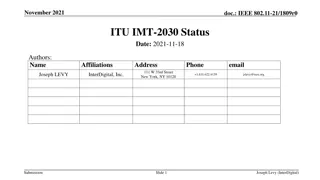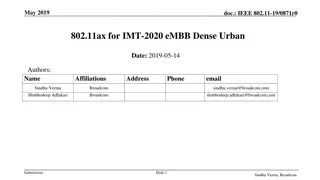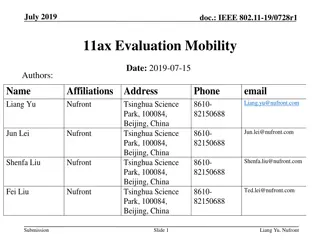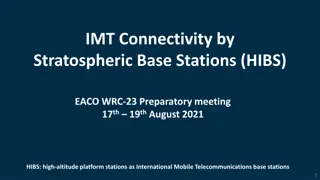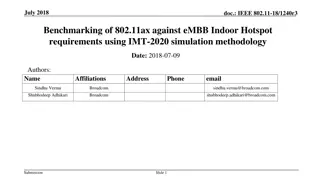Analytical Evaluation of IMT-2020 mMTC and URLLC Requirements in IEEE 802.11-19/0888r0
This contribution analyzes the IMT-2020 mMTC and URLLC requirements in IEEE 802.11-19/0888r0, evaluating the capabilities of 802.11ax technology in meeting these demands. It discusses key aspects such as connection density, message size, delay per user, evaluation scenarios, system configurations, SINR considerations, and the impact of HARQ on spectral efficiency. The evaluation focuses on supporting mMTC devices with varying SINRs and the importance of bandwidth allocation for coverage-limited scenarios.
Download Presentation

Please find below an Image/Link to download the presentation.
The content on the website is provided AS IS for your information and personal use only. It may not be sold, licensed, or shared on other websites without obtaining consent from the author.If you encounter any issues during the download, it is possible that the publisher has removed the file from their server.
You are allowed to download the files provided on this website for personal or commercial use, subject to the condition that they are used lawfully. All files are the property of their respective owners.
The content on the website is provided AS IS for your information and personal use only. It may not be sold, licensed, or shared on other websites without obtaining consent from the author.
E N D
Presentation Transcript
May 2019 doc.: IEEE 802.11-19/0888r0 Discussion on IMT-2020 mMTC and URLLC Date: 2019-05-14 Authors: Name Affiliations Address Phone email Sindhu Verma Shubhodeep Adhikari Broadcom Broadcom sindhu.verma@broadcom.com shubhodeep.adhikari@broadcom.com Submission Slide 1 Sindhu Verma, Broadcom
May 2019 doc.: IEEE 802.11-19/0888r0 Abstract This contribution provides a summary of IMT-2020 mMTC and URLLC requirements and an analytical evaluation of 802.11ax capabilities with respect to them. Submission Slide 2 Sindhu Verma, Broadcom
May 2019 doc.: IEEE 802.11-19/0888r0 mMTC: Summary of requirements With a layer 2 PDU (Protocol Data Unit) message size of 32 bytes and 1 message/day/device or 1 message/2 hours/device: Connection density of 1,000,000 devices per km2. 99thpercentile delay per user less than or equal to 10s Submission Slide 3 Sindhu Verma, Broadcom
May 2019 doc.: IEEE 802.11-19/0888r0 mMTC: Key aspects of the evaluation scenario Evaluation Configuration: Two configurations A and B, 500m ISD and 1732m ISD respectively Sufficient to meet the requirements for only one Carrier frequency 700 MHz Urban Macro topology: Hexagonal layout, 1 site with 3 TRxPs each UE deployment: 80% indoor, 20% outdoor Building type: 80% low loss, 20% high loss Channel model: UMa_A or UMa_B O-to-I loss: UMa_A: 20dB (for <= 6GHz) UMa_B: variable function of penetration loss due to glass and concrete Indoor loss: 0.5*d, d ~ Uniform (0, 25) TRxP Tx Power 49 dBm (20 MHz bandwidth) UE Tx power 23 dBm, UE speed 3 km/hr Up to 64 Rx/Tx antennas at the TRxP Up to 2 Tx/Rx antennas at the UE Evaluations can be either non-full buffer or full buffer System bandwidth of up to 50 MHz (can be distributed across TRxPs) Up to 10 MHz is also possible, but we are not considering it for 11ax Submission Slide 4 Sindhu Verma, Broadcom
May 2019 doc.: IEEE 802.11-19/0888r0 mMTC: Analytical evaluation of 802.11ax From the perspective of spectral efficiency, it is easy to support mMTC as each device may require at most O(100) microseconds to transmit the required small packet even with BPSK/QPSK. The limiting factor is the 10s or less delay to be supported even at 1%ile SINR. The mMTC 1%ile SINR can be low, due to the high loss for some of the Indoor UEs. Problem is more acute at the UL, since DL has a much higher transmit power (49 dBm at DL vs 23 dBm UL). 3GPP has simulated the SINRs in the mMTC topology and they get a 1%ile UL SINR of -5dB. 3GPP has assumed a simpler UE configuration of 1 Tx/Rx, in line with typical simple mMTC devices This means that, 11ax has to support non-zero data rates at the following SINRs: -5dB if it assumes 1 Tx/Rx as 3GPP -2dB if it assumes 2 Tx/Rx, as allowed by IMT 2020. While it may be possible today to meet the requirement at -2dB with advanced receivers in current Wi-Fi, it is much better if sensitivity is improved via HARQ. Also, smaller bandwidth allocation will help for coverage limited scenarios (for example 3GPP assumes min allocations of 180 KHz). Note that while HARQ may sometimes improve spectral efficiency, it will always improve sensitivity relative to ARQ. Submission Slide 5 Sindhu Verma, Broadcom
May 2019 doc.: IEEE 802.11-19/0888r0 URLLC: Summary of requirements Reliability: (1-10 5) success probability of transmitting a layer 2 PDU of 32 bytes within 1 ms at the coverage edge (5%ile SINR), at either DL and UL User Plane Latency: 1 ms assuming unloaded conditions (i.e. a single user) for small IP packets (e.g. 0 byte payload + IP header), for both downlink and uplink. Control Plane Latency: 20 ms (same as in eMBB) Mobility Interruption time: 0 ms (same as in eMBB and needs to be addressed above IEEE 802.11) Submission Slide 6 Sindhu Verma, Broadcom
May 2019 doc.: IEEE 802.11-19/0888r0 URLLC: Key aspects of the evaluation scenario One of 2 evaluation frequencies: 4 GHz and 700 MHz Urban Macro environment (hexagonal layout, 1 site with 3 TRxPs addressing 3 sectors or hexagons) ISD of 500m UEs: 80% outdoor, 20% indoor, Buildings 100% low loss. TRxP Tx Power 49 dBm (20 MHz bandwidth) UE Tx power 23 dBm 10 UEs per TRxP Antenna configuration: TRxP: 64 Tx/Rx for 700 MHz, 256 Tx/Rx for 4 GHz UE: 4 Tx/Rx for 700 MHz, 8 Tx/Rx for 4 GHz UE speed 3 km/hr Indoor and 30 km/hr Outdoor System bandwidth of up to 100 MHz (can be distributed across TRxPs) The reliability and user plane latency requirements must be met at the 5thpercentile downlink or uplink SINR value obtained in the above evaluation scenario. Submission Slide 7 Sindhu Verma, Broadcom
May 2019 doc.: IEEE 802.11-19/0888r0 URLLC: Analytical evaluation of 802.11ax Similar to mMTC, the limiting factor is achieving (1-10 5) success probability of transmitting the required small packet and with 1 ms latency at the 5%ile SINR This requires non-zero data rate with near zero error probability to be supported at 5%ile SINR (possibly with retransmissions) 5%ile SINR from 3GPP simulations varies between -2dB to 2dB (there is wide variation between results from different companies) 11ax may be able to meet the requirement at this SINRs. However, here too, HARQ may become very crucial to meet the very low error probability (0.001% error) at such low SINRs. Submission Slide 8 Sindhu Verma, Broadcom
References May 2019 doc.: IEEE 802.11-19/0888r0 [1] IEEE P802.11ax exchange between systems Local and metropolitan area networks Specific requirements Part 11: Wireless LAN Medium Access Control (MAC) and Physical Layer (PHY) Specifications; Amendment 6: Enhancements for High Efficiency WLAN June 2018 [2] Report ITU-R M.2412-0 (10/2017), Guidelines for evaluation of radio interface technologies for IMT-2020 [3] Report ITU-R M.2410-0 (11/2017), Minimum requirements related to technical performance for IMT-2020 radio interface(s) /D3.0, Draft Standard for Information technology Tele-communications and information Submission Slide 9 Sindhu Verma, Broadcom






